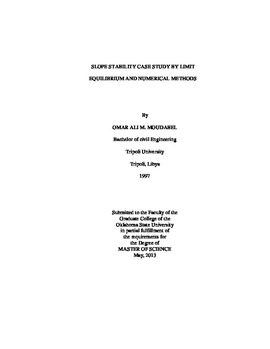| dc.contributor.advisor | Yang, Xiaoming | |
| dc.contributor.author | Moudabel, Omar Ali M. | |
| dc.date.accessioned | 2014-09-24T14:18:11Z | |
| dc.date.available | 2014-09-24T14:18:11Z | |
| dc.date.issued | 2013-05-01 | |
| dc.identifier.uri | https://hdl.handle.net/11244/11111 | |
| dc.description.abstract | Stability analysis of slopes susceptible to different types of failures can be performed with different techniques. The selection of an appropriate technique is, therefore, a very important process of slope stability evaluation. In the assessment of slopes, the factor of safety values still remain the primary index for determining how close or how far slopes are from failure. Traditional limit-equilibrium (LEM) techniques are the most commonly-used analysis methods. Recently, however, the significant computing and memory resources typically available to geotechnical engineers, combined with low costs, have made the Finite Element Method (FEM) or Finite Difference Method (FDM) a viable additional method of analysis. The Shear Strength Reduction (SSR) technique enables FEM or FDM to calculate factors of safety of slopes.In this study, five real case studies that used the Spencer's method, Morgenstern and Price's method, and finite difference method by SSR. The Spencer's and Morgenstern & Price's methods are limit equilibrium methods that satisfy all the static equilibrium condition. On the other hand, FEM or FDM methods are based on SSR. Slope stability of these five different cases was analyzed using LEM and FDM methods. GEOSTASE� software was used for analysis based on LEM, and FLAC� software was used for analysis based on FDM. Factors of safety (FS) values were calculated using both methods, and the results were compared for their applicability. Based on the comparison results, conclusions were drawn on the application of these methods. It was found that the results from these two methods are generally in good agreement. However, it was found in some cases that FDM analysis gave a factor of safety value that was less than the values determined by LEM. This is because the FDM considers more parameters and performs a detailed analysis of stress and strain conditions in the strata under consideration. Although the results may be different, the synergism of both methods can give valuable source of check on the slope failure mechanism. | |
| dc.format | application/pdf | |
| dc.language | en_US | |
| dc.publisher | Oklahoma State University | |
| dc.rights | Copyright is held by the author who has granted the Oklahoma State University Library the non-exclusive right to share this material in its institutional repository. Contact Digital Library Services at lib-dls@okstate.edu or 405-744-9161 for the permission policy on the use, reproduction or distribution of this material. | |
| dc.title | Slope Stability Case Study by Limit Equilibrium and Numerical Methods | |
| dc.type | text | |
| dc.contributor.committeeMember | Gregory, Garry H. | |
| dc.contributor.committeeMember | Cross, Stephen A. | |
| osu.filename | Moudabel_okstate_0664M_12781.pdf | |
| osu.accesstype | Open Access | |
| dc.description.department | Civil & Environmental Engineering | |
| dc.type.genre | Thesis | |
